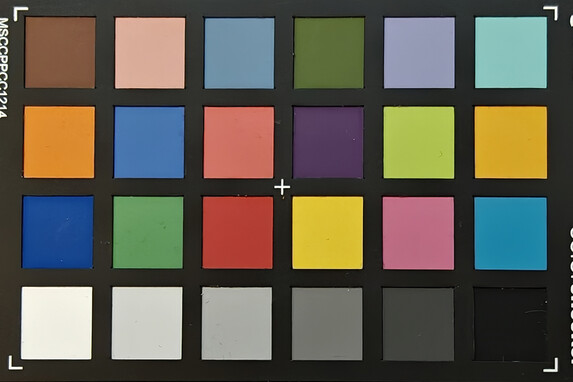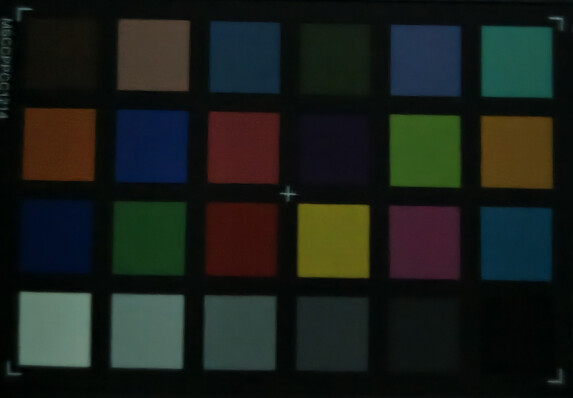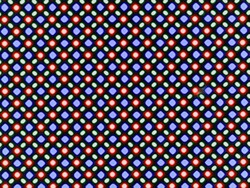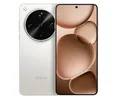Verdict on the Oppo Find X8 Ultra
The Find X8 Ultra is one of the best smartphones of 2025, especially with regard to its cameras' excellent allround qualities. A look at the comparison photos taken on the iPhone 16 Pro shows just how well the Oppo flagship performs—regardless of the native focal length. But even aside from its Hasselblad cameras, the Find X8 Pro's big brother boasts loads of highlights, such as impressive runtimes and high performance with comparatively low throttling.
Oppo hasn't suffered any true blunders with its 2025 flagship; if anything, we see some room for improvement when it comes to the topics of sustainability and updates. Its availability in Europe, where this test was carried out, can also be noted as a negative as a result of a missing global model of the Find X8 Ultra.
Pros
Cons
Price and availability
So far, the Find X8 Ultra has only been presented for the Chinese market. In China, prices start from 6,499 Yuan (around $900).
You can import the phone from Trading Shenzhen for approximately $1,000. It's unlikely that the Ultra model will see a global release.
Table of Contents
- Verdict on the Oppo Find X8 Ultra
- Specifications of the Oppo Find X8 Ultra
- Case - The waterproof high-end phone
- Connectivity - The Android phone with USB 3.2
- Software - The high-end smartphone with Android 15
- Communication and GNSS - The Oppo Find X8 Ultra with 5G
- Telephone functions and call quality - The Oppo phone with dual-SIM support
- Cameras - The flagship smartphone with Sony sensors
- Accessories and warranty - The Android phone with a power supply
- Input devices and operation - The Oppo phone with an ultrasonic sensor
- Display - The Oppo Find X8 Ultra with LTPO
- Performance - The high-end smartphone with a Qualcomm SoC
- Emissions - The Android phone is throttled
- Battery life - The high-end smartphone charges quickly
- Notebookcheck total rating
- Possible alternatives compared
After the release of the Find X8 Pro, Oppo has now presented the Ultra model of its flagship phone, which is said to be better in almost every respect. Different from the Pro version, which features a MediaTek SoC, this model uses a chipset from Qualcomm, namely the Snapdragon 8 Elite.
The highlight of its features is its huge camera module on the back, which in part consists of even larger sensors than Find X8 Pro's camera lineup. It's in this context that Oppo has introduced its new image editing system called Lumo.
Specifications of the Oppo Find X8 Ultra
Case - The waterproof high-end phone
The Oppo Find X8 Ultra has an eye-catching glass case: With a thickness of only 8.78 millimeters and a weight of just 226 grams, it features quite a nifty build despite its 6,100 mAh battery. However, the flagship phone is by no means small with its 6.82-inch screen. The slim bezels around the OLED display which, according to Oppo, measure 1.4 millimeters wide, ensure a high screen-to-body ratio of over 90 percent, resulting in a modern look.
The Find X8 Ultra's haptics are great and its matte frame made from an aluminum alloy not only gives the flagship smartphone stability, but also a nice premium feel. Noteworthy is the button on the left side of its case, which users can freely assign, as well as a capacitive button on the right side that opens the camera app.
The Oppo smartphone's build quality is great and the same can be said for its durability. The Find X8 Ultra has received a five-star certification for drop and fall resistance from the Swiss company SGS, supported by IP68 and IP69 certifications, which protect the case against water and dust. Instead of Gorilla Glass, Oppo uses an unspecified "Crystal Shield" glass.
Connectivity - The Android phone with USB 3.2
In addition to Bluetooth 5.4, NFC, an IR blaster and Miracast, the Find X8 Ultra features a fast USB-3.2 connection (Gen 1) that supports wired image output. USB OTG is also on board, letting users connect peripheral devices to the Oppo phone. It doesn't have an UWB chip, on the other hand.
Software - The high-end smartphone with Android 15
The Find X8 Ultra is set to receive Android operating system upgrades for four years and security updates for five years. This isn't bad, but it's not really good either. Other flagship phones, such as the Galaxy S25 Ultra or Pixel 9 Pro, for example, will receive new Android versions for seven years. Security patches for the Find X8 Ultra will also only be rolled out quarterly; during our test, these were dated April 1, 2025.
Oppo's smartphone comes delivered with Android 15 including the company's own ColorOS 15. Even though the Find X8 Ultra will never officially come to Europe, it still supports a wide range of system languages. There is no PlayStore pre-installed ex works, but it can be easily installed later.
Sustainability
No information on sustainability is available for the Oppo flagship—the manufacturer still has some catching up to do in this case.
Its packaging is free of plastic and has been printed with inks based on soybean oil.
Communication and GNSS - The Oppo Find X8 Ultra with 5G
The Find X8 Ultra's frequency coverage promises no restrictions in Europe. However, the Oppo phone only supports 18 LTE bands. Satellite communication via Tiantong satellites is only available for the Chinese market.
For Wi-Fi connections, the Find X8 Ultra offers the best of the best in the shape of the current Wi-Fi 7 standard, especially since our Chinese version also uses the 6 GHz channel to establish a connection.
However, we only noted average transmission rates of around 600 MBit/s using our Asus AXE11000 reference router. The flagship was significantly faster when receiving.
| Networking | |
| Oppo Find X8 Ultra | |
| iperf3 transmit AXE11000 | |
| iperf3 receive AXE11000 | |
| Xiaomi 15 Ultra | |
| iperf3 transmit AXE11000 | |
| iperf3 receive AXE11000 | |
| iperf3 transmit AXE11000 6GHz | |
| iperf3 receive AXE11000 6GHz | |
| Samsung Galaxy S25 Ultra | |
| iperf3 transmit AXE11000 | |
| iperf3 receive AXE11000 | |
| iperf3 transmit AXE11000 6GHz | |
| iperf3 receive AXE11000 6GHz | |
| Honor Magic7 Pro | |
| iperf3 transmit AXE11000 | |
| iperf3 receive AXE11000 | |
| iperf3 transmit AXE11000 6GHz | |
| iperf3 receive AXE11000 6GHz | |
| Oppo Find X8 Pro | |
| iperf3 transmit AXE11000 6GHz | |
| iperf3 receive AXE11000 6GHz | |
| Average 802.11 a/b/g/n/ac/ax/be | |
| iperf3 transmit AXE11000 | |
| iperf3 receive AXE11000 | |
| iperf3 transmit AXE11000 6GHz | |
| iperf3 receive AXE11000 6GHz | |
| Average of class Smartphone | |
| iperf3 transmit AXE11000 | |
| iperf3 receive AXE11000 | |
| iperf3 transmit AXE11000 6GHz | |
| iperf3 receive AXE11000 6GHz | |
Telephone functions and call quality - The Oppo phone with dual-SIM support
The Oppo smartphone offers full dual-SIM functionality via the 5G network, with two slots for nano SIM cards. Using the Chinese version of Color OS, we didn't have the option to integrate an eSIM in our country.
Even so, users from Europe can also make use of WiFi calling and VoLTE. The phone's call quality via the earpiece was good overall during our test, but our conversation partners sometimes sounded a little muffled. The three microphones recorded our voice clearly.
Cameras - The flagship smartphone with Sony sensors
On paper, the camera setup of the Find X8 Ultra, including its Hasselblad branding, appears to be no different from the Pro model. However, with the exception of its 15 mm lens, the sensors are all different and significantly larger than on the Find X8 Pro or the iPhone 16 Pro.
A 32-MPix lens is used on the front, which can record 4K videos at 60 frames per second. Selfies taken on the Find X8 Ultra appear rich in detail and show good sharpness levels.
The smartphone's 23 mm main camera with a huge 1-inch sensor from Sony (LYT-900) delivers very good photo quality. Thanks to the XXL sensor, backgrounds are usually blurred even when using the regular photo mode. The X8 Find Ultra delivers appealing sharpness and a high dynamic range.
Where the contours of photos taken with an iPhone 16 Pro are already blurred by a pronounced soft focus in direct comparison, such as the church tower or roof shingles in the second test photo, the Oppo flagship delivers plenty of detail. Similar to the Vivo X200 Pro, the Find X8 Ultra has some problems with lens flare and backlit shots.
The Oppo phone also performs really well in low-light scenarios.
The two telephoto lenses with OIS and 3x and 6x lossless zoom also have very large 1/1.56 and 1/1.95-inch sensors for a periscope effect. In conjunction with the digital "AI zoom", the Find X8 Ultra achieves a magnification of up to 120x. The Find X8 Ultra can take really good photos up to 10x, after which it looks somewhat artificial.
Its ultra-wide-angle lens doesn't stand out but is still very competitive. The phone's setup is rounded off by a special spectral sensor, which is designed to ensure accurate colors even under difficult conditions. With Master mode selected, users can make use of the full resolution of the sensors in RAW and JPEG.
You can record video in UHD quality at 120 fps—even in HDR. However, it isn't possible to change lenses at 120 frames per second, as the ultra-wide-angle lens only supports 4K30.
The phone's stabilization and adjustment of its colours and white balance are generally a success.
Image comparison
Choose a scene and navigate within the first image. One click changes the position on touchscreens. One click on the zoomed-in image opens the original in a new window. The first image shows the scaled photograph of the test device.
Main cameraMain cameraLow lightUltra-wide angle

Accessories and warranty - The Android phone with a power supply
The box contains a modular 100-watt fast-charging power supply, a protective cover, a data/charging cable (USB-A to USB-C), a SIM pin and a quick start guide. A film comes pre-installed on its screen.
Our imported device comes with a 12-month warranty. In the event of a warranty claim, Trading Shenzhen offers the option of sending the smartphone to a German shipping address.
Input devices and operation - The Oppo phone with an ultrasonic sensor
The Find X8 Ultra uses an ultrasonic sensor to recognize the user's fingerprint. This is not only more secure than an optical counterpart, as it detects depth and skin structure, but it's also less susceptible to scratches or moisture on your finger. During everyday use, the sensor in the Oppo phone works very quickly and reliably.
If you want to use facial data to unlock the screen, you can do so via the front-facing camera. However, facial biometric identification isn't as secure as it uses a 2D process.
Users benefit from a high screen sampling rate of up to 240 Hz and a refresh rate of 120 Hz. Oppo has installed a great vibration motor, which provides pleasant haptic feedback during everyday use.
Display - The Oppo Find X8 Ultra with LTPO

With a resolution of 3,168 x 1,440 pixels, content is displayed sharply on the phone's 6.82-inch AMOLED panel. Its pixel density is super high at 510 PPI.
Measuring in at 4,202 cd/m², the device's brightness we noted during the more realistic APL18 test was extremely good. Still, OLEDs usually shine a little brighter when playing HDR content. But even so, nothing stands in the way of the phone displaying videos with a wide dynamic and contrast range.
The Find X8 Ultra uses classic pulse width modulation to control its brightness, which, according to the manufacturer, works using PWM dimming and a high frequency of 2,160 Hz. We measured PWM flickering at very low brightness levels, but with a frequency adapted to the device's frame rate.
| |||||||||||||||||||||||||
Brightness Distribution: 95 %
Center on Battery: 1366 cd/m²
Contrast: ∞:1 (Black: 0 cd/m²)
ΔE Color 0.88 | 0.5-29.43 Ø4.83
ΔE Greyscale 1.5 | 0.09-98 Ø5.1
100% sRGB (Calman 2D)
Gamma: 2.303
| Oppo Find X8 Ultra AMOLED, 3168x1440, 6.8" | Xiaomi 15 Ultra AMOLED, 3200x1440, 6.7" | Samsung Galaxy S25 Ultra Dynamic AMOLED 2X, 3120x1440, 6.9" | Honor Magic7 Pro OLED, 2800x1280, 6.8" | Oppo Find X8 Pro AMOLED, 2780x1264, 6.8" | |
|---|---|---|---|---|---|
| Screen | -26% | -84% | 1% | -4% | |
| Brightness middle | 1366 | 1041 -24% | 1357 -1% | 1607 18% | 1167 -15% |
| Brightness | 1325 | 1059 -20% | 1350 2% | 1609 21% | 1160 -12% |
| Brightness Distribution | 95 | 96 1% | 94 -1% | 95 0% | 98 3% |
| Black Level * | |||||
| Colorchecker dE 2000 * | 0.88 | 1 -14% | 3.1 -252% | 0.9 -2% | 0.87 1% |
| Colorchecker dE 2000 max. * | 1.55 | 2.7 -74% | 4.7 -203% | 1.8 -16% | 1.64 -6% |
| Greyscale dE 2000 * | 1.5 | 1.9 -27% | 2.2 -47% | 1.7 -13% | 1.4 7% |
| Gamma | 2.303 96% | 2.23 99% | 2 110% | 2.24 98% | 2.311 95% |
| CCT | 6626 98% | 6697 97% | 6391 102% | 6346 102% | 6426 101% |
* ... smaller is better
Screen Flickering / PWM (Pulse-Width Modulation)
| Screen flickering / PWM detected | 121 Hz Amplitude: 40 % | ||
The display backlight flickers at 121 Hz (worst case, e.g., utilizing PWM) . The frequency of 121 Hz is very low, so the flickering may cause eyestrain and headaches after extended use. In comparison: 53 % of all tested devices do not use PWM to dim the display. If PWM was detected, an average of 8350 (minimum: 5 - maximum: 343500) Hz was measured. | |||
Measurement series with fixed zoom level and different brightness settings (The amplitude curve at minimum brightness looks flat, but this is due to the scaling. The info box shows the enlarged version of the amplitude at minimum brightness).
In addition to selecting various color profiles, users can adjust the Find X8 Ultra's white balance.
We examined its color calibration using the Calman analysis software and a photo spectrometer. With the "Pro" profile selected, we noted the smallest deviations from the reference colors as well as very high color fidelity.
Display Response Times
| ↔ Response Time Black to White | ||
|---|---|---|
| 0.9 ms ... rise ↗ and fall ↘ combined | ↗ 0.4 ms rise | |
| ↘ 0.5 ms fall | ||
| The screen shows very fast response rates in our tests and should be very well suited for fast-paced gaming. In comparison, all tested devices range from 0.1 (minimum) to 240 (maximum) ms. » 2 % of all devices are better. This means that the measured response time is better than the average of all tested devices (20.5 ms). | ||
| ↔ Response Time 50% Grey to 80% Grey | ||
| 2 ms ... rise ↗ and fall ↘ combined | ↗ 0.9 ms rise | |
| ↘ 1.1 ms fall | ||
| The screen shows very fast response rates in our tests and should be very well suited for fast-paced gaming. In comparison, all tested devices range from 0.165 (minimum) to 636 (maximum) ms. » 8 % of all devices are better. This means that the measured response time is better than the average of all tested devices (32.1 ms). | ||
Performance - The high-end smartphone with a Qualcomm SoC
The Find X8 Ultra was mostly on par with the competition with the Snapdragon 8 Elite, but the Oppo phone sometimes performed worse during the AI test.
Still, the Adreno 830 in the Find X8 Ultra performed particularly well during the GFXBench test.
| UL Procyon AI Inference for Android - Overall Score NNAPI | |
| Oppo Find X8 Pro | |
| Samsung Galaxy S25 Ultra | |
| Honor Magic7 Pro | |
| Xiaomi 15 Ultra | |
| Average of class Smartphone (1267 - 81594, n=145, last 2 years) | |
| Average Qualcomm Snapdragon 8 Elite (8865 - 22767, n=13) | |
| Oppo Find X8 Ultra | |
GFXBench (DX / GLBenchmark) 2.7: T-Rex Onscreen | 1920x1080 T-Rex Offscreen
GFXBench 3.0: on screen Manhattan Onscreen OGL | 1920x1080 1080p Manhattan Offscreen
GFXBench 3.1: on screen Manhattan ES 3.1 Onscreen | 1920x1080 Manhattan ES 3.1 Offscreen
GFXBench: on screen Car Chase Onscreen | 1920x1080 Car Chase Offscreen | on screen Aztec Ruins High Tier Onscreen | 2560x1440 Aztec Ruins High Tier Offscreen | on screen Aztec Ruins Normal Tier Onscreen | 1920x1080 Aztec Ruins Normal Tier Offscreen | 3840x2160 4K Aztec Ruins High Tier Offscreen
| 3DMark / Wild Life Extreme Unlimited | |
| Samsung Galaxy S25 Ultra | |
| Oppo Find X8 Ultra | |
| Honor Magic7 Pro | |
| Xiaomi 15 Ultra | |
| Oppo Find X8 Pro | |
| 3DMark / Wild Life Extreme | |
| Samsung Galaxy S25 Ultra | |
| Oppo Find X8 Ultra | |
| Oppo Find X8 Pro | |
| Xiaomi 15 Ultra | |
| Honor Magic7 Pro | |
| 3DMark / Wild Life Unlimited Score | |
| Samsung Galaxy S25 Ultra | |
| Oppo Find X8 Ultra | |
| Honor Magic7 Pro | |
| Xiaomi 15 Ultra | |
| 3DMark / Solar Bay Score | |
| Samsung Galaxy S25 Ultra | |
| Oppo Find X8 Ultra | |
| Honor Magic7 Pro | |
| Xiaomi 15 Ultra | |
| Oppo Find X8 Pro | |
| 3DMark / Solar Bay Unlimited Score | |
| Samsung Galaxy S25 Ultra | |
| Oppo Find X8 Ultra | |
| Honor Magic7 Pro | |
| Xiaomi 15 Ultra | |
| Oppo Find X8 Pro | |
| 3DMark / Steel Nomad Light Unlimited Score | |
| Oppo Find X8 Ultra | |
| Samsung Galaxy S25 Ultra | |
| Xiaomi 15 Ultra | |
| Xiaomi 15 Ultra | |
| Honor Magic7 Pro | |
| Oppo Find X8 Pro | |
| 3DMark / Steel Nomad Light Score | |
| Samsung Galaxy S25 Ultra | |
| Oppo Find X8 Ultra | |
| Honor Magic7 Pro | |
| Xiaomi 15 Ultra | |
| Xiaomi 15 Ultra | |
| Oppo Find X8 Pro | |
| GFXBench (DX / GLBenchmark) 2.7 / T-Rex Onscreen | |
| Xiaomi 15 Ultra | |
| Samsung Galaxy S25 Ultra | |
| Honor Magic7 Pro | |
| Oppo Find X8 Pro | |
| Oppo Find X8 Ultra | |
| GFXBench (DX / GLBenchmark) 2.7 / T-Rex Offscreen | |
| Oppo Find X8 Ultra | |
| Oppo Find X8 Pro | |
| Xiaomi 15 Ultra | |
| Samsung Galaxy S25 Ultra | |
| Honor Magic7 Pro | |
| GFXBench 3.0 / Manhattan Onscreen OGL | |
| Xiaomi 15 Ultra | |
| Samsung Galaxy S25 Ultra | |
| Honor Magic7 Pro | |
| Oppo Find X8 Pro | |
| Oppo Find X8 Ultra | |
| GFXBench 3.0 / 1080p Manhattan Offscreen | |
| Samsung Galaxy S25 Ultra | |
| Oppo Find X8 Pro | |
| Xiaomi 15 Ultra | |
| Oppo Find X8 Ultra | |
| Honor Magic7 Pro | |
| GFXBench 3.1 / Manhattan ES 3.1 Onscreen | |
| Xiaomi 15 Ultra | |
| Samsung Galaxy S25 Ultra | |
| Honor Magic7 Pro | |
| Oppo Find X8 Pro | |
| Oppo Find X8 Ultra | |
| GFXBench 3.1 / Manhattan ES 3.1 Offscreen | |
| Oppo Find X8 Pro | |
| Oppo Find X8 Ultra | |
| Honor Magic7 Pro | |
| Xiaomi 15 Ultra | |
| Samsung Galaxy S25 Ultra | |
| GFXBench / Car Chase Onscreen | |
| Honor Magic7 Pro | |
| Samsung Galaxy S25 Ultra | |
| Xiaomi 15 Ultra | |
| Oppo Find X8 Pro | |
| Oppo Find X8 Ultra | |
| GFXBench / Car Chase Offscreen | |
| Oppo Find X8 Ultra | |
| Xiaomi 15 Ultra | |
| Oppo Find X8 Pro | |
| Honor Magic7 Pro | |
| Samsung Galaxy S25 Ultra | |
| GFXBench / Aztec Ruins High Tier Onscreen | |
| Honor Magic7 Pro | |
| Samsung Galaxy S25 Ultra | |
| Xiaomi 15 Ultra | |
| Oppo Find X8 Pro | |
| Oppo Find X8 Ultra | |
| GFXBench / Aztec Ruins High Tier Offscreen | |
| Oppo Find X8 Ultra | |
| Samsung Galaxy S25 Ultra | |
| Xiaomi 15 Ultra | |
| Oppo Find X8 Pro | |
| Honor Magic7 Pro | |
| GFXBench / Aztec Ruins Normal Tier Onscreen | |
| Xiaomi 15 Ultra | |
| Samsung Galaxy S25 Ultra | |
| Honor Magic7 Pro | |
| Oppo Find X8 Pro | |
| Oppo Find X8 Ultra | |
| GFXBench / Aztec Ruins Normal Tier Offscreen | |
| Oppo Find X8 Ultra | |
| Xiaomi 15 Ultra | |
| Honor Magic7 Pro | |
| Oppo Find X8 Pro | |
| Samsung Galaxy S25 Ultra | |
| GFXBench / 4K Aztec Ruins High Tier Offscreen | |
| Oppo Find X8 Ultra | |
| Samsung Galaxy S25 Ultra | |
| Xiaomi 15 Ultra | |
| Honor Magic7 Pro | |
| Oppo Find X8 Pro | |
| Jetstream 2 - 2.0 Total Score | |
| Samsung Galaxy S25 Ultra (Chrome 132) | |
| Honor Magic7 Pro (Chrome 131) | |
| Xiaomi 15 Ultra (Chrome 132) | |
| Oppo Find X8 Pro (Chrome 131) | |
| Average Qualcomm Snapdragon 8 Elite (75.1 - 289, n=14) | |
| Average of class Smartphone (13.8 - 387, n=158, last 2 years) | |
| Speedometer 2.0 - Result | |
| Samsung Galaxy S25 Ultra (Chrome 132) | |
| Honor Magic7 Pro (Chrome 131) | |
| Xiaomi 15 Ultra (Chrome 132) | |
| Average Qualcomm Snapdragon 8 Elite (244 - 419, n=6) | |
| Oppo Find X8 Pro (Chrome 131) | |
| Average of class Smartphone (15.2 - 585, n=140, last 2 years) | |
| Speedometer 3.0 - Score | |
| Samsung Galaxy S25 Ultra (Chrome 132) | |
| Honor Magic7 Pro (Chrome 131) | |
| Xiaomi 15 Ultra | |
| Average Qualcomm Snapdragon 8 Elite (15.3 - 34, n=12) | |
| Oppo Find X8 Pro (Chrome 131) | |
| Average of class Smartphone (1.03 - 34, n=104, last 2 years) | |
| WebXPRT 4 - Overall | |
| Samsung Galaxy S25 Ultra (Chrome 132) | |
| Honor Magic7 Pro (Chrome 131) | |
| Average Qualcomm Snapdragon 8 Elite (125 - 255, n=13) | |
| Xiaomi 15 Ultra (Chrome 132) | |
| Oppo Find X8 Pro (Chrome 131) | |
| Oppo Find X8 Ultra (Chrome 136) | |
| Average of class Smartphone (22 - 273, n=152, last 2 years) | |
| Octane V2 - Total Score | |
| Samsung Galaxy S25 Ultra (Chrome 132) | |
| Honor Magic7 Pro (Chrome 131) | |
| Average Qualcomm Snapdragon 8 Elite (25448 - 95506, n=17) | |
| Xiaomi 15 Ultra (Chrome 132) | |
| Oppo Find X8 Pro (Chrome 131) | |
| Oppo Find X8 Ultra (Chrome 136) | |
| Average of class Smartphone (2228 - 100368, n=205, last 2 years) | |
| Mozilla Kraken 1.1 - Total | |
| Average of class Smartphone (277 - 28190, n=161, last 2 years) | |
| Oppo Find X8 Pro (Chrome 131) | |
| Oppo Find X8 Ultra (Chrome 136) | |
| Average Qualcomm Snapdragon 8 Elite (383 - 873, n=14) | |
| Xiaomi 15 Ultra (Chrome 132) | |
| Honor Magic7 Pro (Chrome 131) | |
| Samsung Galaxy S25 Ultra (Chrome 132) | |
* ... smaller is better
| Oppo Find X8 Ultra | Xiaomi 15 Ultra | Samsung Galaxy S25 Ultra | Honor Magic7 Pro | Oppo Find X8 Pro | Average 512 GB UFS 4.1 Flash | Average of class Smartphone | |
|---|---|---|---|---|---|---|---|
| AndroBench 3-5 | -1% | -11% | -7% | -21% | 5% | -33% | |
| Sequential Read 256KB | 3754.43 | 4109.79 9% | 3823.28 2% | 3910.81 4% | 3482.9 -7% | 3945 ? 5% | 2135 ? -43% |
| Sequential Write 256KB | 3564.22 | 3761.19 6% | 3361.24 -6% | 3683.81 3% | 3498.5 -2% | 3501 ? -2% | 1729 ? -51% |
| Random Read 4KB | 375.9 | 312.69 -17% | 287.85 -23% | 282.34 -25% | 375.7 0% | 346 ? -8% | 292 ? -22% |
| Random Write 4KB | 389.28 | 379.29 -3% | 331.61 -15% | 357.04 -8% | 100.4 -74% | 490 ? 26% | 334 ? -14% |
Emissions - The Android phone is throttled
Temperature
Temperature development is not a problem for the Oppo flagship—not even under permanent load. Its performance development during the Wild Life stress tests of 3DMark was comparatively constant and only led to a moderate throttling.
(-) The maximum temperature on the upper side is 49.4 °C / 121 F, compared to the average of 35.1 °C / 95 F, ranging from 21.9 to 63.7 °C for the class Smartphone.
(-) The bottom heats up to a maximum of 47.2 °C / 117 F, compared to the average of 34.1 °C / 93 F
(+) In idle usage, the average temperature for the upper side is 29.2 °C / 85 F, compared to the device average of 32.8 °C / 91 F.
3DMark Steel Nomad stress test
| 3DMark | |
| Wild Life Stress Test Stability | |
| Oppo Find X8 Pro | |
| Oppo Find X8 Ultra | |
| Xiaomi 15 Ultra | |
| Honor Magic7 Pro | |
| Samsung Galaxy S25 Ultra | |
| Wild Life Extreme Stress Test | |
| Oppo Find X8 Ultra | |
| Xiaomi 15 Ultra | |
| Oppo Find X8 Pro | |
| Samsung Galaxy S25 Ultra | |
| Solar Bay Stress Test Stability | |
| Oppo Find X8 Ultra | |
| Xiaomi 15 Ultra | |
| Oppo Find X8 Pro | |
| Samsung Galaxy S25 Ultra | |
| Honor Magic7 Pro | |
| Steel Nomad Light Stress Test Stability | |
| Oppo Find X8 Ultra | |
| Honor Magic7 Pro | |
| Xiaomi 15 Ultra | |
| Oppo Find X8 Pro | |
| Samsung Galaxy S25 Ultra | |
Speakers
The Find X8 Ultra's stereo speakers offer a good sound, but they lack a little depth and the high tones broke down significantly in the pink noise measurement. Alternatively, sound can be output via USB-C or Bluetooth 5.4.
Oppo Find X8 Ultra audio analysis
(+) | speakers can play relatively loud (84.2 dB)
Bass 100 - 315 Hz
(±) | reduced bass - on average 14.4% lower than median
(±) | linearity of bass is average (12.7% delta to prev. frequency)
Mids 400 - 2000 Hz
(+) | balanced mids - only 4.3% away from median
(+) | mids are linear (5.7% delta to prev. frequency)
Highs 2 - 16 kHz
(+) | balanced highs - only 4.3% away from median
(±) | linearity of highs is average (7.2% delta to prev. frequency)
Overall 100 - 16.000 Hz
(±) | linearity of overall sound is average (16.2% difference to median)
Compared to same class
» 5% of all tested devices in this class were better, 4% similar, 91% worse
» The best had a delta of 12%, average was 36%, worst was 134%
Compared to all devices tested
» 24% of all tested devices were better, 5% similar, 70% worse
» The best had a delta of 4%, average was 24%, worst was 134%
Oppo Find X8 Pro audio analysis
(+) | speakers can play relatively loud (87.8 dB)
Bass 100 - 315 Hz
(-) | nearly no bass - on average 17.9% lower than median
(±) | linearity of bass is average (9.6% delta to prev. frequency)
Mids 400 - 2000 Hz
(+) | balanced mids - only 2.7% away from median
(+) | mids are linear (3.8% delta to prev. frequency)
Highs 2 - 16 kHz
(+) | balanced highs - only 4.3% away from median
(+) | highs are linear (4.5% delta to prev. frequency)
Overall 100 - 16.000 Hz
(+) | overall sound is linear (13.8% difference to median)
Compared to same class
» 0% of all tested devices in this class were better, 1% similar, 99% worse
» The best had a delta of 12%, average was 36%, worst was 134%
Compared to all devices tested
» 14% of all tested devices were better, 4% similar, 82% worse
» The best had a delta of 4%, average was 24%, worst was 134%
Battery life - The high-end smartphone charges quickly
Power consumption
In our measurements, the Oppo phone was revealed to have a high level of efficiency.
Its 6,100 mAh battery can be charged at up to 100 watts, and wirelessly at a maximum of 50 watts. Using the included power adapter, we noted a charging time of around 40 minutes.
| Off / Standby | |
| Idle | |
| Load |
|
Key:
min: | |
| Oppo Find X8 Ultra 6100 mAh | Xiaomi 15 Ultra 5410 mAh | Samsung Galaxy S25 Ultra 5000 mAh | Honor Magic7 Pro 5270 mAh | Oppo Find X8 Pro 5910 mAh | Average Qualcomm Snapdragon 8 Elite | Average of class Smartphone | |
|---|---|---|---|---|---|---|---|
| Power Consumption | 24% | 0% | -16% | 25% | -11% | -3% | |
| Idle Minimum * | 0.8 | 0.49 39% | 0.55 31% | 0.94 -18% | 0.6 25% | 0.876 ? -10% | 0.87 ? -9% |
| Idle Average * | 1.1 | 0.87 21% | 0.77 30% | 1.5 -36% | 0.8 27% | 1.446 ? -31% | 1.424 ? -29% |
| Idle Maximum * | 1.6 | 0.94 41% | 0.91 43% | 1.57 2% | 0.9 44% | 1.655 ? -3% | 1.586 ? 1% |
| Load Average * | 8.5 | 8.82 -4% | 13.81 -62% | 11.03 -30% | 6.8 20% | 8.76 ? -3% | 7.13 ? 16% |
| Load Maximum * | 11.8 | 9.26 22% | 16.69 -41% | 11.68 1% | 10.9 8% | 12.5 ? -6% | 10.8 ? 8% |
* ... smaller is better
Power consumption: Geekbench (150 cd/m²)
Power consumption: GFXbench (150 cd/m²)
Runtimes
The flagship phone delivered very good runtimes during our battery tests.
Best comparability is provided by the results relevant to everyday use at an adjusted display brightness (150 cd/m²). In this scenario, the Find X8 Ultra lasted almost 23 hours when surfing on Wi-Fi.
During the endless video playback test without WiFi, we even measured over 30 hours.
| Oppo Find X8 Ultra 6100 mAh | Xiaomi 15 Ultra 5410 mAh | Samsung Galaxy S25 Ultra 5000 mAh | Honor Magic7 Pro 5270 mAh | Oppo Find X8 Pro 5910 mAh | |
|---|---|---|---|---|---|
| Battery Runtime | -13% | -4% | -1% | 1% | |
| H.264 | 2011 | 1650 -18% | 1935 -4% | 1806 -10% | 1976 -2% |
| WiFi v1.3 | 1374 | 1270 -8% | 1331 -3% | 1481 8% | 1411 3% |
Notebookcheck total rating
The Oppo Find X8 Ultra offers some of the best hardware and outstanding camera quality.
Oppo Find X8 Ultra
- 05/27/2025 v8
Marcus Herbrich
Possible alternatives compared
Image | Model / Review | Price | Weight | Drive | Display |
|---|---|---|---|---|---|
| Oppo Find X8 Ultra Qualcomm Snapdragon 8 Elite ⎘ Qualcomm Adreno 830 ⎘ 16 GB Memory, 512 GB | Amazon: 1. $15.12 [4 Pack] for Oppo Find X8 Ul... 2. $6.27 [1-Pack] for Oppo Find X8 Ul... 3. $24.29 AKABEILA [3 Pack Screen Prot... List Price: 1050€ | 226 g | 512 GB UFS 4.1 Flash | 6.82" 3168x1440 510 PPI AMOLED | |
| Xiaomi 15 Ultra Qualcomm Snapdragon 8 Elite ⎘ Qualcomm Adreno 830 ⎘ 16 GB Memory, 512 GB | Amazon: 1. $9.59 Zeking [2 Pack for Xiaomi 15... 2. $6.99 Kicvbnco 3 Pack For Xiaomi 1... 3. $11.99 Ibywind Screen Protector For... List Price: 1499€ | 229 g | 512 GB UFS 4.1 Flash | 6.73" 3200x1440 521 PPI AMOLED | |
| Samsung Galaxy S25 Ultra Qualcomm Snapdragon 8 Elite for Galaxy ⎘ Qualcomm Adreno 830 ⎘ 12 GB Memory, 256 GB | Amazon: 1. $16.99 Super Fast Charger Type C, 2... 2. $13.59 AACL 3-Pack for Samsung Gala... 3. $7.98 firtstnow 3 Pack Glass Scree... List Price: 1449€ | 218 g | 256 GB UFS 4.0 Flash | 6.90" 3120x1440 498 PPI Dynamic AMOLED 2X | |
| Honor Magic7 Pro Qualcomm Snapdragon 8 Elite ⎘ Qualcomm Adreno 830 ⎘ 12 GB Memory, 512 GB | Amazon: 1. $11.99 Ibywind Screen Protector For... 2. $7.99 Lucyliy (3 Pack) Compatible ... 3. $8.99 MOOISVS 2+2Pack for Honor Ma... List Price: 1300€ | 223 g | 512 GB UFS 4.0 Flash | 6.80" 2800x1280 453 PPI OLED | |
| Oppo Find X8 Pro Mediatek Dimensity 9400 ⎘ ARM Immortalis-G925 MC12 ⎘ 16 GB Memory, 512 GB | Amazon: 1. $15.99 AKABEILA [3 Pack Privacy Scr... 2. $12.02 [1-Pack] for Oppo Find X8 Pr... 3. $9.99 WRTBS Phone Case for Oppo Fi... List Price: 1199€ | 215 g | 512 GB UFS 4.0 Flash | 6.78" 2780x1264 450 PPI AMOLED |
Transparency
The selection of devices to be reviewed is made by our editorial team. The test sample was provided to the author as a loan by the manufacturer or retailer for the purpose of this review. The lender had no influence on this review, nor did the manufacturer receive a copy of this review before publication. There was no obligation to publish this review. We never accept compensation or payment in return for our reviews. As an independent media company, Notebookcheck is not subjected to the authority of manufacturers, retailers or publishers.
This is how Notebookcheck is testing
Every year, Notebookcheck independently reviews hundreds of laptops and smartphones using standardized procedures to ensure that all results are comparable. We have continuously developed our test methods for around 20 years and set industry standards in the process. In our test labs, high-quality measuring equipment is utilized by experienced technicians and editors. These tests involve a multi-stage validation process. Our complex rating system is based on hundreds of well-founded measurements and benchmarks, which maintains objectivity. Further information on our test methods can be found here.












































































 Total Sustainability Score:
Total Sustainability Score: 

















